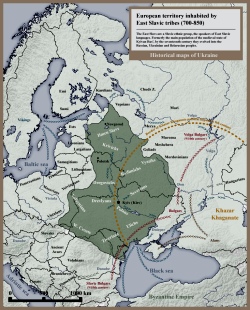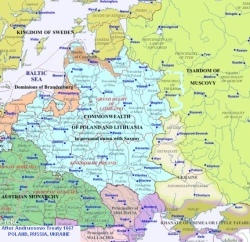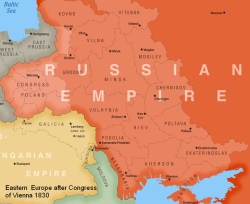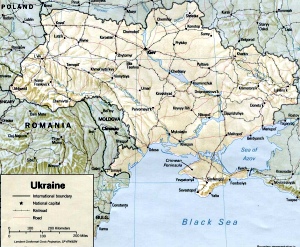

This article covers only major incidents. Go to links to get more detail. Click on maps to get larger size.
Varangian Rurik Rus' Dynasty: Development of Ukrainian Identity; Ukraine divided ;
Communist Era; Ukraine independent!; Crimea
In recent weeks there as been much discussion about the historical relationship between Ukraine and Russia. Why the enmity between them?
This article provides a simplified and brief review of this complex subject.
The earliest recorded history goes back to the 8th. and 9th. centuries. Numerous east Slavonic tribes resided in the area colored dark green on the map.
Numerous east Slavonic tribes resided in the area colored dark green on the map.
The Turkic nomadic tribes Khazars ruled the area to the south east.
The entire area north of the Black Sea up to the bend in the Dnieper river, was peopled by successive Turkic nomadic tribes, who settled briefly in the area and then migrated westward to central and south-eatern Europe under pressue of new tribes moving in from the east - Avars, Bulgars, Magyars, Pechenegs (9th century), Cumans 10th-11th centuries). In Crimea and at the mouths of rivers, trading posts which had been established by the ancient Greeks, were now outposts of the Byzantine Empire (Constantinople).
In the 8th and 9th centuries Varangians (a Viking tribe), called Variags by the Slavs, came from Scandinavia and traveled along the rivers trading with Byzantium and the eastern nations and established trading posts and strongholds on the rivers, the most important Holmgard (later named Novgorod) on the Volkhov River near Lake Ilmen.
They took on leadership roles over the Slavic tribes.
Rurik became the ruling chief in Novgorod around the year 860. His descendants, ruled the east Slavic lands until the early 17th century.
Prince Oleg, the regent of Rurik's young son Igor, captured the most north-western Khazar outpost, Sambat on a hill overlooking the Dnieper river, in 882. Oleg consolidated his power over the surrounding region and the riverways north to Novgorod, imposing tribute on the East Slav tribes. He established the town Kiev - Ukrainian Київ (Kyiv) - on the site of Sambat and moved his headquarters from Novgorod.
Rurik's great-grandson Grand Prince Vladimir I (Vladimir the Great) formed an alliance with Byzantium (Constantinople), married the sister of Byzantine emperor Basil II and became a Christian in 988, then pushed the conversion of the pagan tribes that he had conquered. In this endeavor he was aided by the Greek monks Cyril and Methodius, who created the Cyryllic alphabet (by adding characters to the Greek alphabet to convey Slavic sounds) and translated part of the bible into the Slavonic language.
He was succeeded by Yaroslav the Wise, whose reign as Grand Prince of Kiev (1019-1054) marked the apogee of Kievan Rus'. Yaroslav codified laws, made shrewd alliances, supported arts and architecture.
Unfortunately he divided rule amongst his sons, who later fought each other for power. Kievan Rus' fell into decline hastened by attacks by the Mongols from the east.
Around 1240 Batu Khan, a grandson of Genghiz Khan, destroyed all the major cities of Kievan Rus' except Novgorod and Pskov. The regional princes were forced to send regular tribute to the Tatar state, which became known as the Empire of the Golden Horde.
In 1299 the Head of the Orthodox Church (Metropolitan) was transferred to Vladimir in the north and later to the new city of Moscow
Of all the Rus' principalities those with major influence in the 13th and 14th centuries were Novgorod and Vladimir-Suzdal, but all were plagued by the continual fighting for power by the descendants of Vladimir the Great.
The Republic of Novgorod resisted the autocratic rule of the Prince of Moscow. The merchant families had retained personal privileges since the time it was established in the 9th. century. This ended when Moscow Grand Prince Ivan IV (Ivan the Terrible) declared himself Tsar of all Russia in 1547. In the massacre of 1570 all the nobility of Novgorod were murdered as well as several thousand citizens. This is the start of the absolute rule of the Russan Tsars.
The regional princes and land-owning boyars jealously maintained their isolation and power and slowly removed the freedom of the local peasants, who became serfs - defacto slaves - of the landowners.
At the beginning of the 18th century, Peter the Great tried to break this isolation and rule of Moscow by building a new capital (St.Petersburg) with access to the sea, he tried to introduce western culture and education to Russia, but the boyars and the Orthodox church fiercely resisted.
By the end of the 14th century all the western Rus' principalities had become occupied or fiefdoms of the Polish crown or the Lithuanian dukes. Smolensk was a province of the Polish-Lithuanian kingdom from the early 1400's until 1654.
The pricipality of
Halych-Volhynia, present day Western Ukraine, was created in 1199 by the union of two seperate Rurik principalties. In 1270 Prince Lev built present day Lviv and moved his capital from Halych. Weakened by Mongol invasions in the 13th century, the principality was incorporated into the Kingdom of Poland by Casimir the Great in 1340. Polish/Lithuanian princes pushed eastward, fighting Tatars and later Turks. Most of the Rus' princely families in the region became Polonized. By the mid 17th century Poland controlled virtually all of the lands that are now part of modern Ukraine. Only the land immediately adjacent to the Black Sea remained under virtual Ottoman Turk control,
During this 400 year period the western oriented Ruthenian (later called Ukrainian) culture and language developed. Polish and Lithuanian princely families, such as Radziwill, Potocki, Czartorycki and Sapieha, ruled the land, but the local peasant population, beside having to serve in the princely armies and pay tribute in produce, enjoyed considerable freedom, compared to what was happening in the north.

The Cossacks of the steppes between the Dnieper and Don rivers played an important role in the quest for Ukrainian independence. Renowned for their military prowess, both as horsemen and foot soldiers, they served as mercenaries for and against Poles and Russians, in the numerous wars against Turks and Tatars during the 14th to 18th centuries. The name is derived from an old Slavonic word meaning "free men". It is believed that they were descendants of the original nomadic Cumans that wandered in the steppes north of the Black Sea before recorded history, mixed with descendants of Slavic women captured or raped during successive invasions. They were also joined by Ukrainian and Russian serfs escaping from servitude. They lived in fortified villages sich, many on islands along the rapids around the big bend of the Dnieper river. They were ruled by councils of elders and elected leaders called hetman.
There were many short-lived rebellions against the Polish overlords, but none as successful as that by Hetman Bohdan Khmelnytski (1648-1655). He gained support of the Ukrainian peasants and small landowners and promised to create an independent Rus' state. With the help of Crimean Tatars (whom the Cossacks had previously been fighting as part of the Polish forces) and Russians, with whom Khmelnytski had negotiated a treaty of support at Pereyaslav in 1654, the Cossaks caused great devastation of the Polish estates and towns. At the time Poland was weakened by successive wars and a Swedish invasion.
In 1658, at Hadiach, Poland concluded an agreement with representtives of the Cossacks and the Ukrainian landowners which created a Duchy of Rus' with equal rights and privileges to Poles and Lithuanians. However many wanted total independence and refused to honor the agreement which soon became mute.
The Russians commenced a new war against Poland which ended in 1667 with the treaty of Andrusovo in which Poland ceded to Russia the entire left bank of the Dnieper river and the city of Kiev, also the principality of Smolensk - see map above. For a while the Cossacks were able to maintain a semi-autonomous Hetmanate of Zaporizhian Cossacks, but the Russians continually eroded the rights of the Hetmanate.
Hetman Mazepa allied the Cossacks with the Swedes in the Great Northern War. Peter the Great defeated th Swedes at the Battle of Poltava in 1708. Hundreds of Cossacks were killed or executed. Finally in 1764, Catherine the Great abolished the Hetmanate and fully incorporated its territory into the Russian empire. Cossacks continued to serve as great fighters in special regiments of the Russian army.
Poland had become essentially a democratic republic in 1572. While still ruled by kings, they were elected by the seym, a parliament made up of landowners. The increasing clout of the princely magnates (who competed for influence), and continual wars with Russia, Sweden, and the Turkish Ottomans, led to a steady decline of Poland's power and influence in eastern Europe. The last great Polish king was Jan Sobieski who defeated the Turks at the Battle of Vienna in 1683. 
In 1772 the neighboring states of Austria, Prussia and Russia started carving up weakened Poland between them. By 1795 Poland had ceased to exist. The land of Ukrainian people was divided up and not reunited until 1945 (except for very brief intervals). The largest part was occupied by Russia, the small western portion, essentially the ancient principality of Halych , became the province of Galicia under Austrian rule until 1918, then under Polish rule between the two World Wars.
In the area under Russian control Ukrainian nationalism was severely restricted. Catherine the Great legalized serfdom in Ukraine, forbiding peasants to leave an estate without the landlord's permission and allowing the landlords to punish them at will. Until 1905 th use of Ukrainian language was prohibited. Ironically, Polish and Rus' landowners who pledged allegiance to the Tsar were allowed to keep their land. The estates of recalitrant Poles and Ukrainians were given to Russians. The fertile black soil of the steppes made the landowners wealthy - Ukraine was called the "breadbasket of Europe".
The situation was quite different in Austrian Galicia. Serfdom had been abolished throughout the Austrian empire in 1781. The peasants remained poor because their properties were small, but they were supposed to be paid for working on the larger estates, mainly owned by Poles. In predominently Ukrainian or Rusyn speaking regions there were schools teaching in their language.
After the reforms which resulted from the peasant uprising in 1848, Ukrainians participated in the provincial parliament. although Polish representatives held the majority.
Ukrainian language newspapers and literature were published, mainly in the provincial capital Lwów (Lemberg in German, Lviv in Ukrainian).
1914 World War I engulfed Europe. Initially Russian armies occupied the eastern half of Austrian Galicia, but in 1915 the Germans and Austrians pushed the demoralized Russian troops eastward.
In October 1917 the Communist Revolution engulfed Russia. German troops advanced to the Dnieper to ensure the supply of grain to starving central Europe. The peasants divided up the large estates. The Ukrainian National Republic was declared in 1917 with military units made up of deserters from the Russian army, volunteers and some Cossack units. Hampered by pro-Bolshevik Ukrainians (mainly factory workers and some peasants) and lack of support from the White Russian forces, who were also fighting the Red Bolshevik armies, the effort collapsed in late 1920 and its leaders fled into exile in Poland.
In 1921 Galicia became part of the Polish Republic, the rest of Ukraine became Ukrainian Socialist Soviet Republic. Less than half of the executive was of Ukrainian nationality, all important executive matters were decided by the Central Committee in the Kremlin and support of the population was minimal. Initially, in an effort to gain popular support, the Ukrainian language, literature and culture were promoted.
In 1928 Stalin initiated a new 5-year plan of industrialization and collectivization of farms. At the same time decrees were issued against nationalistic "deviations". Liyerature and newspapers in the Ukrainian language were prohibited. Among the many massacres of Ukrainians was that at Vinnytsia in 1937-38, over 9,000 men and women were executed. The kulaks (so-called wealthy peasants) were systematically destroyed by huge taxes and confiscation of harvests and animals.
This resulted in the 1932-1933 genocide - 4 to 5 million Ukrainians starved to death in the famine. Whole families were deported to gulags in Siberia.
Ukrainians in Poland fared much better, but were dissatisfied because of lack of economic opportunity and discrimination. In September 1939 the Ribbentrop-Molotow agreement gave Poland east of the river Bug to the Soviet Union. Initially the Ukrainian population greeted the Soviet troops enthusiastically but were soon disillusioned as the NKVD conducted mass arrests and executions of Ukrainian intelligentsia, and peasants' farms were confiscated.
22 June 1941 German forces invaded Russia. In Lviv, 30 June 1941, the Organization of Ukrainian Nationalits proclaimed Ukrainian statehood. There have been recorded instances of German troops being greeted as liberators by local population. However, Nazi racist policy considered all Slavic people to be destined to be slaves abd treated Ukrainians just as brutally as the Russians. Stephen Bandera and all his associates were arrested and sent to a concentratin camp. Only later, when the war was going badly, did the Nazis try to recruit Ukrainians into a Waffen-SS unit called "Galizien".
The Ukrainian Partisan Army was one of several partisan groups fighting behind the front lines against German forces. When the Germans were retreating in 1943, they turned their efforts against the Soviets and eventually in 1945 and 1946 against the Poles.
Ukrainian cities and villages, industry, infrastructure were almost totally destroyed during the war. It is estimated that Ukraine lost 19% of its population - 2.5 million military, 5.5 million civilians. Note that almost 20% of these losses were due to Soviet, not German, action. After the war was over Stalin ordered the deportation of hundreds of thousands to Siberia in retaliation for "aiding the enemy". Likewise many of the survivors of Nazi concentration camps, forced labor and prisoners of war were arrested and deported or executed, when they were repatriated from Germany, for "failing to resist" - these included ethnic Russians, Ukrainians and other nationalities of the Soviet Republics.
1953, March 5, Stalin died. In December Beria, the head of the NKVD, was executed. The era of terror had ended. Kruschev became First Secretary and leader of the Soviet Union. In February 1956, at the 20th Communist Party Congress Kruschev gave his speech denouncing Stalin.
Succesive leaders, ending with Gorbachev, tried to improve conditions in the Soviet Union. It became steadily weaker. December 26, 1991 the Soviet Union ceased to exist.
 The Supreme Soviet (parliament) of the Ukrainian SSR overwhelmingly approved the Act of Declaration of Independence. Initially the country was still run by the Communist party. In a national referendum on December 1, 90% of the population voted for independence. December 2, Canada and Poland became the first countries to formally recognize Ukraina as an independent republic, followed by Russia.
The Supreme Soviet (parliament) of the Ukrainian SSR overwhelmingly approved the Act of Declaration of Independence. Initially the country was still run by the Communist party. In a national referendum on December 1, 90% of the population voted for independence. December 2, Canada and Poland became the first countries to formally recognize Ukraina as an independent republic, followed by Russia.
1996, June 28, a new, democratic constitution was adopted. It mandates a pluralistic political system with protection of basic human rights and liberties, and a presidential form of government.
In 1954 Crimea was transferred from the Russian Soviet Socialist Republic to the Ukrainian SSR by decree of the Supreme Soviet, in which Kruschev was the First Secretary. The reason for this was never clear, Crimea had never been part of Ukraine, although the northern part was captured by Kievan Rus' princes in the 12th century. The fact that Sevastopol was the base for the Soviet Black Sea fleet makes this decision even more questionable. This latter fact was the source of considerable friction between the new Ukrainian state and Russia in the 190s.
Originally a Greek, then Roman colony, Crimea was taken over by the Mongol Golden Horde in the 13th century. In 1399 Timur (Tamerlane) captured Crimea and established it as the Crimean Tatar Khanate. This lasted until Catherine the Great captured Crimea at the end of the 18th century and incorporated it into the Russian empire. Numerous Russians (and other nationalities) settled and soon made up about half the population.
After World War II Stalin deported all of the non-Russian population to Siberia, for "aiding the enemy" during the brief German occupation in 1942. More than half of them perished. After the end of Communism, many surviving Tatars returned to Crimea and currently make up about 10% of the population.
The earliest written history of the East Slavic people is the Nestor chronicle written by the monk Nestor around 1100. No copies of it exist, but later chronicles included major portions of it - the Laurentian Codex written by a monk in Nizny Novgorod in 1377 - the Hypatian Codex, written about 1425 in monasteries around Kyiv. Information from these sources is also corrorobated, in part, by Arab, Jewish and Nordic contemporary accounts.
According to early medieval chronicles, the name Rus' - in Russian Русь - was given to the new people from Scandinavia and to the lands that they ruled, hence Kievan Rus', Novgorod Rus'
about 10% of the population.Some sources justify the Crimean transfer by claiming that Kruschev was an Ukrainian. This is false. Although he was head of the Ukrainian Soviet ruling committee for several years, he was a Russian and was responsible for the murder of thousands of Ukrainians.
Return to top of page.
Go to "Home page.
Index to many articles about historical events, current events, genealogy.
Early Rus'people
U.S. based Ukrainian website
with lots of interesting information.
